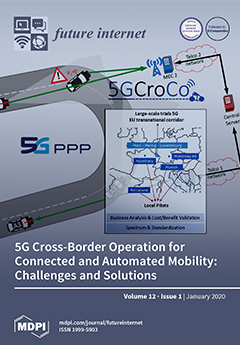Open AccessArticle
5G Cross-Border Operation for Connected and Automated Mobility: Challenges and Solutions
by
Apostolos Kousaridas, Andreas Schimpe, Sebastian Euler, Xavier Vilajosana, Mikael Fallgren, Giada Landi, Francesca Moscatelli, Sokratis Barmpounakis, Francisco Vázquez-Gallego, Roshan Sedar, Rodrigo Silva, Laurent Dizambourg, Stefan Wendt, Maciej Muehleisen, Kurt Eckert, Jérôme Härri and Jesus Alonso-Zarate
Cited by 32 | Viewed by 6741
Abstract
The vision of cooperative, connected and automated mobility (CCAM) across Europe can only be realized when harmonized solutions that support cross-border traffic exist. The possibility of providing CCAM services along different countries when vehicles drive across various national borders has a huge innovative
[...] Read more.
The vision of cooperative, connected and automated mobility (CCAM) across Europe can only be realized when harmonized solutions that support cross-border traffic exist. The possibility of providing CCAM services along different countries when vehicles drive across various national borders has a huge innovative business potential. However, the seamless provision of connectivity and the uninterrupted delivery of services along borders also poses interesting technical challenges. The situation is particularly innovative given the multi-country, multi-operator, multi-telco-vendor, and multi-car-manufacturer scenario of any cross-border layout. This paper introduces the challenges associated to a cross-border deployment of communication technologies through the analysis of three use cases: tele-operated driving, high-definition map generation and distribution for autonomous vehicles, and anticipated cooperative collision avoidance. Furthermore, a set of 5G solutions have been identified to ensure that CCAM services can be supported efficiently in cross-border scenarios. Faster handover of a data connection from one operator to another, generalized inter-mobile edge computing (MEC) coordination, and quality of service (QoS) prediction are some of the solutions that have been introduced to reduce the uncertainties of a real 5G cross-border deployment.
Full article
►▼
Show Figures





